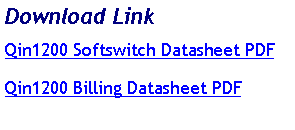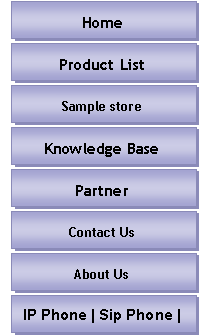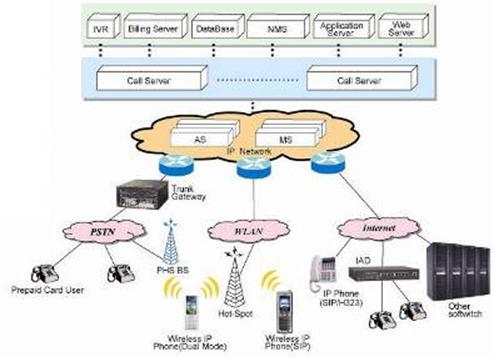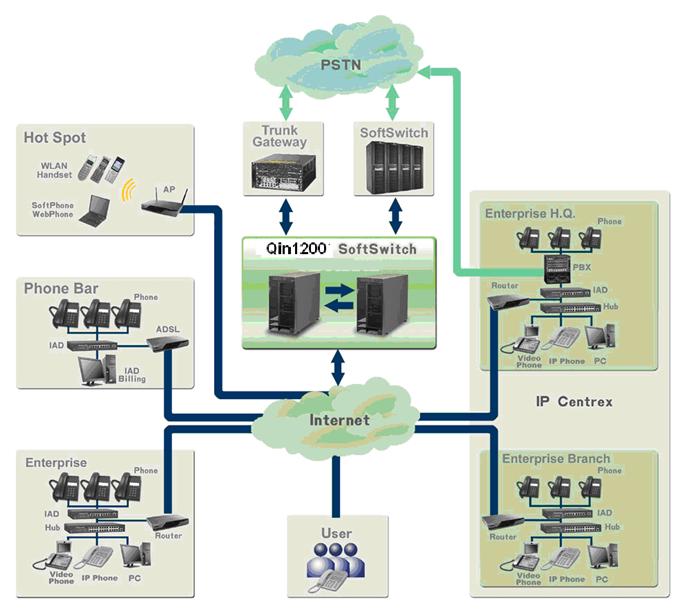|
1.System Function
|
|
Item
|
Specification
|
Description
|
|
VoIP protocol
|
SIP(RFC3261)/H.323(V2, V3, V4)
|
SIP2.0 (RFC3261)
|
|
Audio CODECs
|
G.723.1/G.729/G.711
|
|
|
Video CODECs
|
H.263
|
|
|
DTMF
|
RFC2833/INFO/H.245
|
SIP(RFC 2833 and INFO), H.323(H.245 User Input Indication)
|
|
System Interconnecting
|
H.323 Gateway mode
|
Inter work with other GWs, as GW, no registration
|
|
H.323 Gateway registration mode
|
Inter work with 3rd party Gatekeeper or Soft Switch by registering with them as GW
|
|
H.323 Gatekeeper mode
|
Inter work with 3rd GW or Soft Switch by accepting their registrations as a Gatekeeper
|
|
SIP UA mode
|
Inter work with other SIP UAs, as UA, no registration
|
|
SIP UA registration mode
|
Inter work with 3rd party SIP Proxy or Soft Switch by registering with them as UA
|
|
SIP Proxy mode
|
Inter work with 3rd UA or Soft Switch by accepting their registrations as a SIP proxy
|
|
Authentication mode
|
Device ID mode
|
Fit for SIP and H.323 registration
|
|
Device ID + IP mode
|
Fit for SIP and H.323 registration
|
|
User name + Password mode
|
Fit for SIP registration and call
|
|
Number Binding
|
Support PSTN number binding with CPE
|
support global roaming by binding a device with multiple phone numbers
|
|
Routing Plan
|
Support multiple routing Plan
|
Routing definition by number prefix
|
|
Routing distribution
|
Distributing routing by priority, percentage and time
|
|
Automatic routing retry
|
Automatic routing retry when previous try receives error code from trunking or detects timeout
|
|
Value-added Services
|
Number display
|
Incoming caller number display/Outgoing caller number blocking
|
|
Reject/Accept anonymous call
|
|
|
Call restriction/Permission
|
|
|
Call forward
|
Call forward unconditional, Call forward busy, Call forward no answer, Call forward offline
|
|
Call transfer
|
Support SIP signaling mode and DTMF mode
|
|
Call hold/Retrieve
|
|
|
Number transform
|
Support transforming caller or callee number by settings
|
|
Dial pattern
|
|
|
Abbreviated dialing
|
Support self-service setting
|
|
IP Centrex services
|
Enterprise grouping
|
Support multiple enterprises and multiple groups per enterprise
|
|
Enterprise extension number
|
Short extension number dialing in every enterprise
|
|
DID(Direct Inward Dialing)
|
Support calling enterprise extension number using its E.164 number directly from outside
|
|
Group ringing
|
All available group extensions ring at the same time, when any extension accepts the call, other extensions stop ringing. Allow for configuring ringing duration
|
|
Group hunting
|
Select an extension by random or alphabetical order
|
|
Group IVR
|
Support automatic/manual attendant, allow for customizing Greeting
|
|
Call Park/Call Pickup
|
|
|
Distinctive ringing
|
Device support required
|
|
Line group
|
Allow every enterprise have its own PSTN routing capability
|
|
Additional service modules
|
Prepaid card(Calling Card)
|
Billing system required
|
|
Registered call Authentication Module
|
Authenticate PSTN caller number, allow for binding multiple caller number, support direct or indirect dialing
|
|
Follow me Service Module
|
Support One-number and personal IP calling, allowing for binding multiple Caller numbers
|
|
Voice mail Module
|
Allow for receiving voice mail by IVR, Web or Email.
add-on module required
|
|
Voice conference Module
|
Support multiple concurrent conference rooms, support password protection. add-on module required
|
|
Web Phone Module
|
Support Web Phone and Web800 services. Add-on module required
|
|
IVR
|
Voice prompt
|
Call failure prompt, account balance prompt
|
|
Calling card IVR flow
|
Support multiple IVR access number per IVR flow
|
|
Prepaid account recharge IVR flow
|
|
|
Automatic attendant IVR flow
|
Automatic virtual attendant for enterprise user
|
|
System configuration
|
Web Configuration GUI
|
Support multi-level administrators
|
|
Batch add/delete users
|
|
|
Intelligent wizard
|
Simplifying configuration process
|
|
Self-service configuration
|
Allow user to query/configure personal services
|
|
Logging
|
Operation log record and management
|
|
Network management system
|
System status monitoring
|
Status monitoring for servers, devices and calls
|
|
Realtime call/registration trace
|
Call trace, registration trace, realtime call/registration linear graph
|
|
Exception alerting
|
Allerting for server exception, resource usage exception
|
|
Statistics
|
History calls statistics, alerting records statistics
|
|
Logging
|
Operation log record. Allow for adjusting log level
|
|
Billing system
|
Support OpenSP-T Billing system
|
Refer to OpenSP-T Billing Specification
|
|
2. System capacity
|
|
Item
|
Maximum value(Related to hardware performance and network environment)
|
Description
|
|
Devices
|
50,000
|
Additional cascaded modules required for supporting this maximum device capacity
|
|
Device Ports
|
100,000
|
Additional cascade modules required for supporting this maximum port capacity
|
|
Concurrent calls
|
5,000
|
Additional cascade modules required
|
|
CPS
|
<=20 Call Per Second
|
|
|
3.System platform
|
|
OS
|
RedHat Linux 9.0
RedHat Enterprise Linux 3
|
|
|
Database
|
Oracle 9i for Linux or PostgreSQL
|
PostgreSQL for small-scale customer
|







